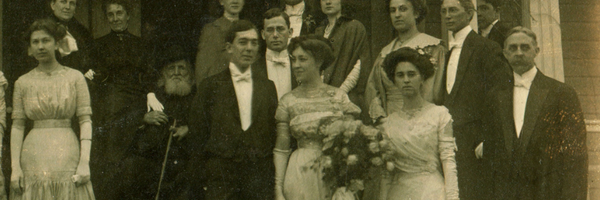The History of Tuxedos
Jan 16, 2020

There are two theories about the first tuxedo.
The tuxedo was invented by Pierre Lorillard IV of New York City according to one school of thought. However, some historians believe that the tuxedo was invented by King Edward VII.
British Origins
A resident of Tuxedo Park, James Brown Potter vacationed in England in the summer of 1886. Potter and his wife, Cora were introduced to the Prince of Wales {who later became King Edward VII} at a court ball in London. Potter asked the Prince for advice on formal dress. The Prince sent Potter to his own Saville Row tailor, Henry Poole & Co. Potter was fitted with a short black jacket and black tie that was unlike the formal tails with white tie that was worn in the United States for formal occasions. The new tailless formal wear was said to have been designed by the Prince of Wales. The Prince and his tailor drew inspiration from the British military uniforms of the time, which used short jackets with black ties.
Tuxedo Park, NY
Pierre Lorillard's family were wealthy tobacco magnates who owned country property in Tuxedo Park, just outside of New York City. At a formal ball, held at the Tuxedo Club in October 1886, the young Lorillard wore a new style of formal wear for men that he designed himself at a time when men only wore Tailcoats with white bowties. Lorillard had the tails removed from his Tailcoat and wore the Satin Lapel Dinner Jacket to the First Autumn Ball. He named his tailless black jacket the tuxedo after Tuxedo Park. The tuxedo caught on and became fashionable as formal wear for men.
This is where the two origins meet. James Brown Potter took the design back to the Tuxedo Club, where Pierre Lorillard modified it, named it, and made it popular during the Autumn ball.
Tuxedos suffered from a drop in popularity during the first World War. Then, a major rise in formal dress occurred in the '30s. Tuxes were, yet again, considered the preferred type of evening wear. White-tie was reserved for special occasions only.
Black wool tuxedos were the standard until the 1930s saw a major rise in the midnight blue tuxedo. By the time 1935 rolled around, more mills were making blue tuxedo wool than black. The double-breasted tuxes, which previously were considered very informal, exploded in popularity. People even began wearing white tuxedo jackets, primarily in warmer climates.
In the 1970s, disco saw a surge of wild-colored tuxes in pastel blues, pinks, greens, oranges and yellows in a variety of patterns and textures too. It certainly wasn't formal, but it was an instantly recognizable look. By the '80s, ruffled shirts, bell bottoms, and patterned tuxedo jackets were out of fashion. It was a colorful, bright moment for the tux.
In the 1980s, tuxes went back to their typical black and blue looks. This was favored even more throughout the 1990s and early '00s. During this time, tuxedos had grown to become more and more formal.
Innovation has carried the tuxedo from a single-breasted peak lapel style to many others including the always
appropriate notch lapel, the single and double breasted shawl collar, and the double breasted peak lapel. Tuxedos range from one to as many as four or five buttons with one being the most traditional.


